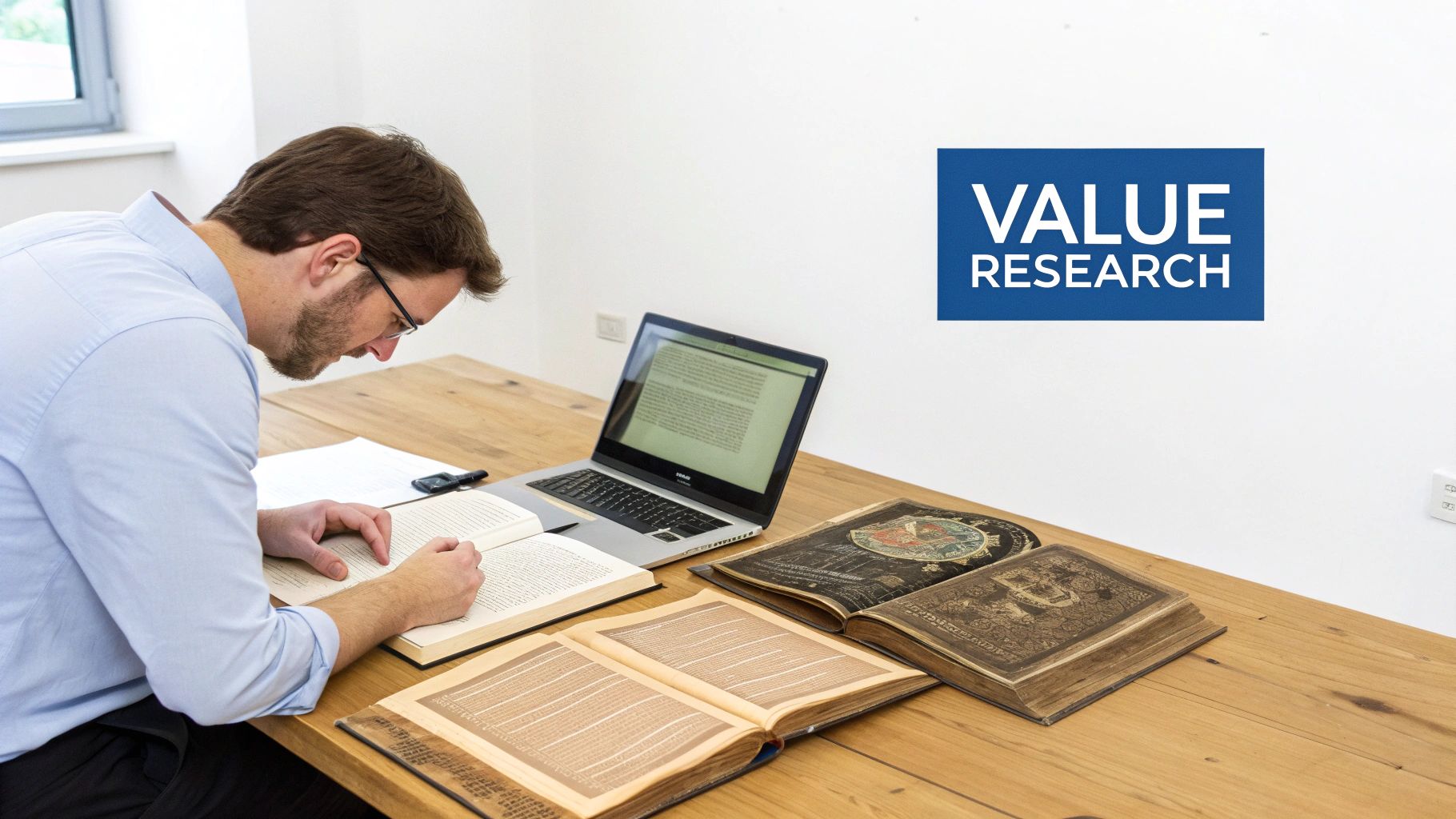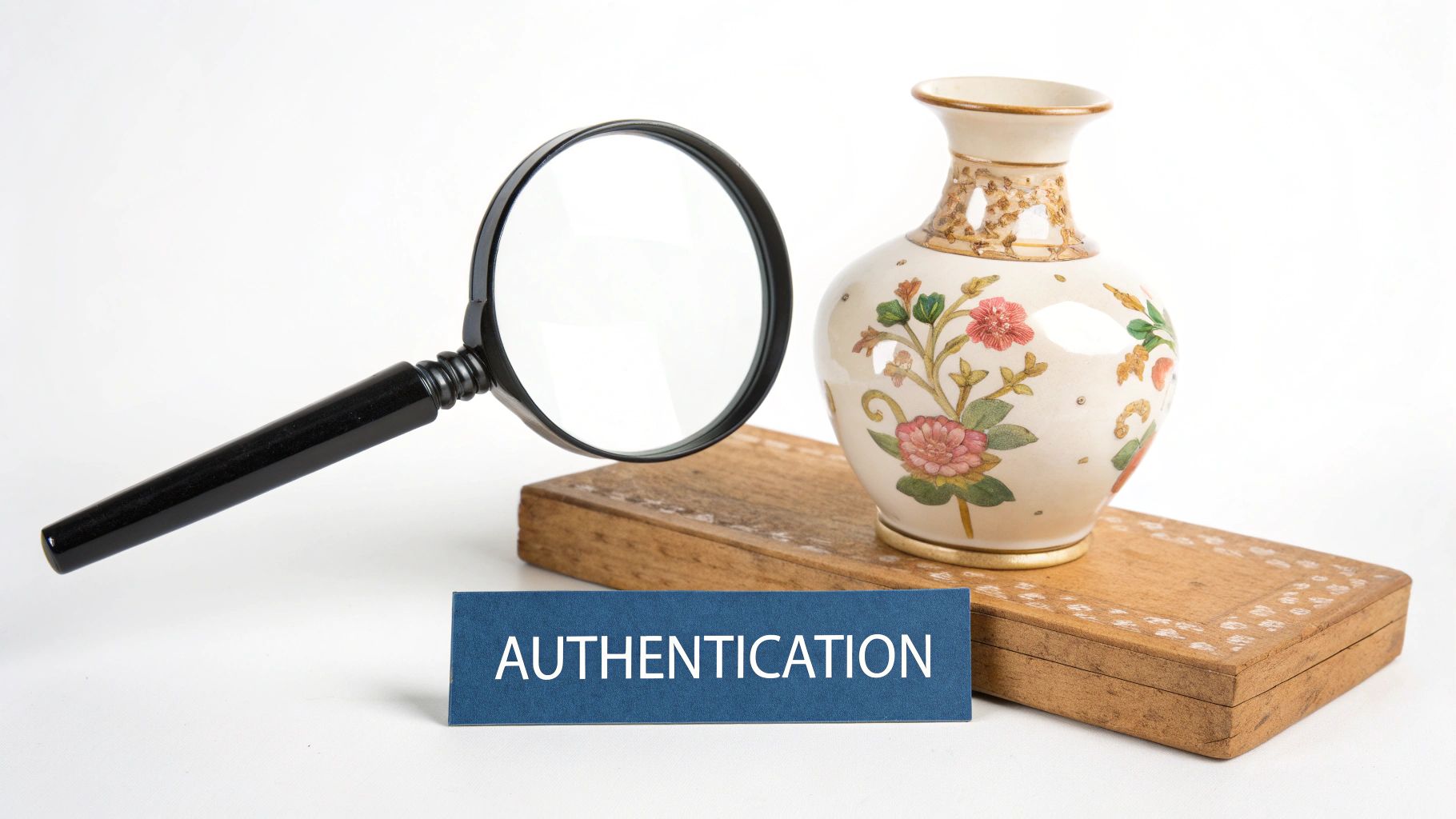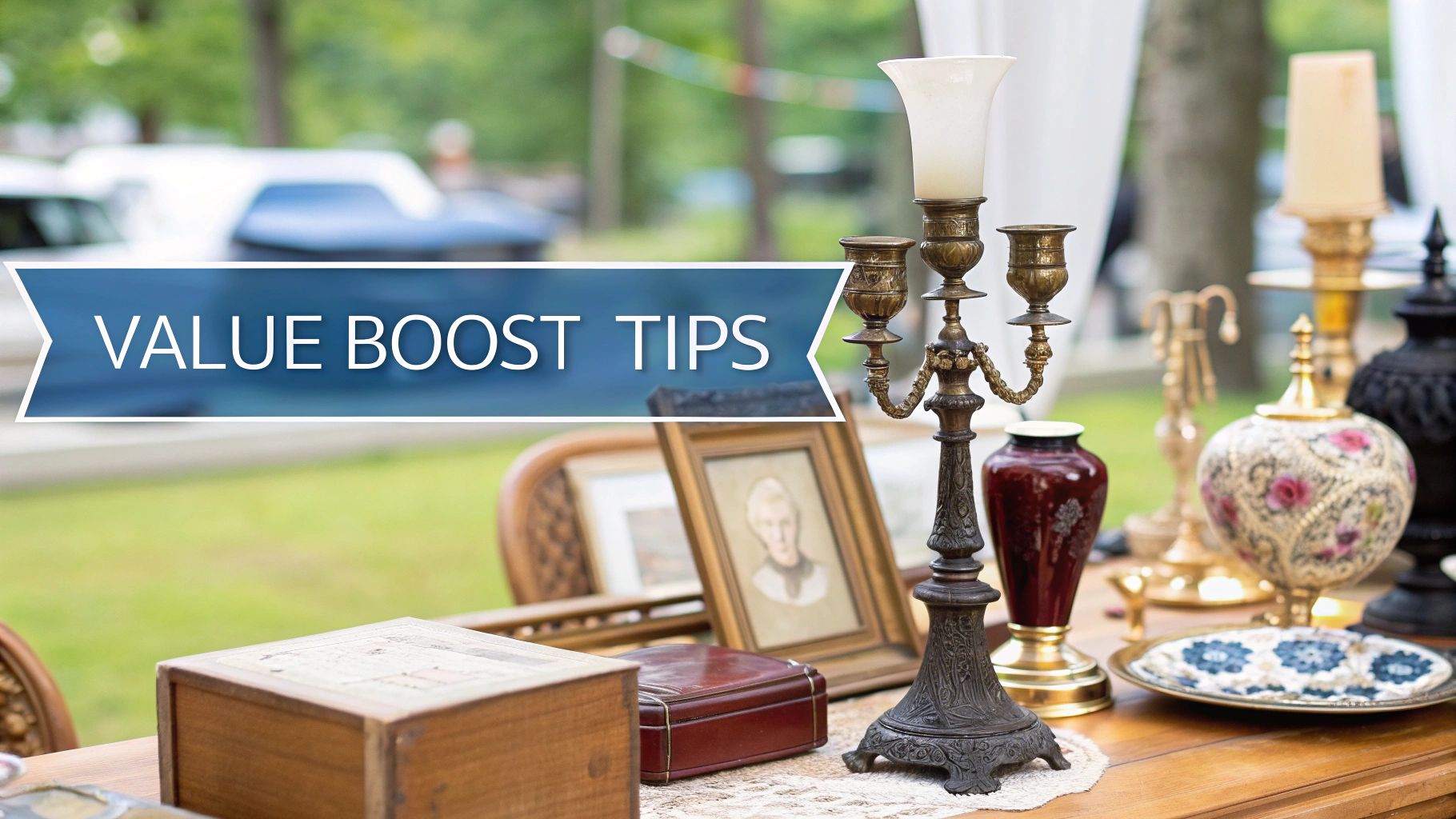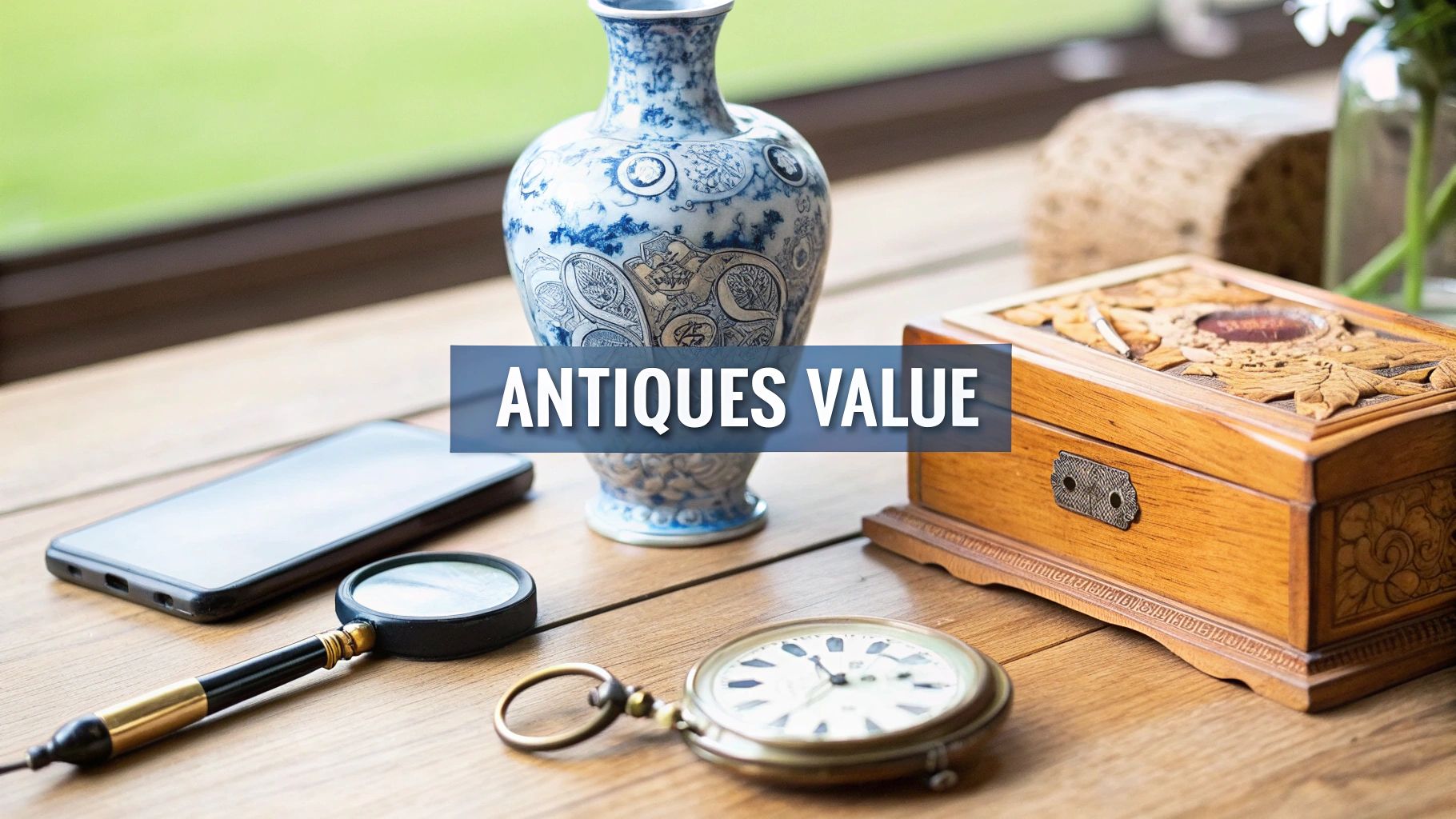So, you're wondering what your antiques are actually worth. It's about more than just age. The real value is a mix of things—condition, rarity, its history (what we call provenance), and what people are willing to pay for it right now. Ultimately, an item is only worth what a buyer will pay for it today.
A Quick Guide to Valuing Your Antiques
Ever look at that old chair in the attic or a dusty set of dishes from your grandmother and wonder if you're sitting on a hidden treasure? You're not alone. Figuring out the value of an antique is a bit like being a detective. You do some digging, some research, and you start to piece together the story. It's fascinating how two items that look almost identical can have wildly different price tags because of tiny, subtle details.
Think of this guide as your first step. It’s a way to do a quick assessment to see if you have something with serious market potential or a beloved family heirloom whose value is purely sentimental.
The Four Pillars of an Antique's Value
Before you get too deep in the weeds, it helps to know the main things that appraisers and serious collectors look at. These four elements work together to create the full picture of an item's worth.
Here's a quick look at the primary elements that appraisers use to determine an antique's market worth.
| Factor | What It Means for Value | Example of a High-Value Indicator |
|---|---|---|
| Condition | How well has it survived? Damage, repairs, and missing parts can drastically lower value. | An 18th-century porcelain vase with no chips, cracks, or restorations. |
| Rarity | Is it one of a kind, or were thousands made? The harder it is to find, the more it's worth. | A limited-edition piece of furniture from a famous designer. |
| Provenance | What's its story? A documented history linking it to someone famous or a historic event adds immense value. | A pocket watch with papers proving it was owned by a historical figure. |
| Desirability | Is it in style? Market trends and what's popular with collectors and designers heavily influence price. | A mid-century modern Eames chair, which is highly sought-after right now. |
Understanding these factors is the foundation for accurately assessing any antique you might own. Let's break them down a bit more.
Condition: This is a big one. An item in pristine, original shape will almost always fetch more than one with chips, cracks, or clunky repairs. A little patina—that gentle wear that comes with age—can be a good thing, but outright damage is not.
Rarity: It really comes down to supply and demand. How many of these were ever made? More importantly, how many are still around? A rare piece from a well-known maker or in an unusual style will command a higher price simply because it’s hard to find.
Provenance: This is the item's life story, and a good story can be worth a lot of money. If you have documentation that links an antique to a famous person, a historical event, or a major collection, its value can skyrocket.
Desirability: Let's face it, trends matter in the antiques world, too. What’s hot with collectors and interior designers right now has a huge impact on price. For example, mid-century modern furniture is in high demand, which has pushed its value way up in recent years.
Uncovering the Clues Hidden in Your Antique

Before you can even begin to think about what your antique is worth, you have to play detective. Every single piece holds a story, and the clues are often hiding in plain sight. These are the very first details a professional appraiser or a serious buyer will hunt for, so getting familiar with them yourself puts you way ahead of the game.
Your first move is to carefully inspect your item for any kind of identifying mark. Think of these as the fingerprints left behind by the person or company that created it.
Finding Maker's Marks and Signatures
A maker's mark is simply a stamp, a signature, or a symbol that points back to the creator. Where you'll find them really depends on the item. On furniture, I always check the back, underneath the piece, or inside the drawers. For anything like porcelain or ceramics, flip it over—the mark is almost always on the bottom. If you're looking at silverware, check along the stem or the back of the handle.
These marks can be incredibly subtle. For example, a tiny, almost unreadable stamp on an old silver spoon could be the mark of a famous silversmith, which would instantly make it far more valuable. This is where a good magnifying glass becomes your best friend.
Pro Tip: Don't just look for a name. Sometimes, the "mark" is a series of small symbols or even just a number. These can tell you everything from the origin and date to the authenticity of a piece. Write down or photograph everything you find, no matter how small it seems.
When you do find a mark, grab your phone and take the clearest photo you can. This picture will be absolutely vital when you start your research. The specific design of a company’s logo, for instance, can often pinpoint the decade it was made.
How to Honestly Assess the Condition
Next comes the hard part: you have to be brutally honest about the item's condition. This means looking at your piece with a critical eye and noting every single flaw. A detailed and accurate condition report is the foundation for any realistic valuation.
Be on the lookout for these common issues:
- Chips and Cracks: Run your fingers along the edges, handles, and any delicate parts. Even a hairline crack counts.
- Repairs: Can you spot a bit of old glue? Mismatched paint? Or maybe modern screws on a piece of antique furniture? Previous repairs, especially shoddy ones, can seriously drag down the value.
- Wear and Patina: Take note of scratches, worn-off gilding, or faded colors. While some signs of age (what we call patina) can actually be a good thing, major damage is a big red flag.
Going through this process doesn't just get you ready for a valuation; it also gives you a much deeper connection to the object’s unique history and the journey it’s been on.
How to Photograph Antiques for Accurate Appraisals

When you're trying to figure out what your antiques are worth online, the photos you submit are everything. A dark, blurry picture isn't just unhelpful—it can lead to a completely wrong valuation or, even worse, a lowball offer from a potential buyer.
The good news is you don’t need a fancy camera rig. Your smartphone is perfectly fine for the job.
It all starts with good lighting. Find a spot with plenty of bright, indirect natural light. Think near a window on an overcast day. You want to avoid harsh, direct sun, which casts strange shadows and can blow out the color.
Then, find a clean, simple background. A plain wall, a solid-colored sheet, or even a big piece of poster board will do the trick. You want your antique to be the star, with no distracting clutter in the background.
Tell the Whole Story With Your Photos
To give an appraiser the full picture, you need to think like you're giving them a virtual tour of the piece. A simple shot list helps make sure you don't miss any of the small details that can make a big difference in the final value.
Here’s a quick rundown of the essential shots you'll need:
- The Full View: Snap a few pictures of the entire piece from every angle—front, back, top, and bottom.
- The Details: Get in close on any interesting features. Think intricate carvings, decorative inlays, or unique hardware.
- The Maker's Mark: This is often the most important shot. Get a crystal-clear, focused picture of any signatures, stamps, or labels.
- The Flaws: Don't hide the damage. Photograph any chips, cracks, repairs, or scratches. Being upfront about condition is key to getting a trustworthy appraisal.
An appraiser can only evaluate what they can see. Taking a few extra minutes to capture clear, detailed photos gives them the information they need to give you a valuation you can trust.
For an even deeper dive into getting those perfect shots, our guide on how to photograph antiques has a ton of great tips.
Uncovering Your Antique's Value Online
Alright, with all your notes and photos in hand, we get to the fun part: finding out what your piece might actually be worth. Kicking off your research online is the best way to get a realistic baseline. The single most important rule here? Always, always look for sold prices, not what people are asking.
There are some great places to start. While big-name auction houses like Christie's have amazing archives, they're usually packed with ultra high-end stuff. For the rest of us, sites like eBay and LiveAuctioneers are goldmines for understanding what everyday antiques are really selling for right now.
On eBay, your best friend is the "Sold Items" filter. Think of it this way: an asking price is just a guess, but a sold price is a hard fact. Ticking that one little box turns a chaotic marketplace into a powerful database of what buyers have actually paid.
For instance, here’s a look at the sold listings for an "antique dresser." See how it shows what people were genuinely willing to shell out?

This gives you a concrete price range to work with, not just wishful thinking from a seller.
How to Search Like a Pro
Getting accurate results depends entirely on how well you search. Start broad with a term like "antique silver spoon," and then start layering in the details you uncovered earlier.
A few tips to narrow it down:
- Add the Maker: Try "Gorham sterling silver spoon" instead.
- Include the Style: Get more specific with "Art Nouveau sterling spoon."
- Specify the Material: Something like "19th-century mahogany dresser" works wonders.
- Mention Unique Features: Don't forget details like "dresser with marble top."
It's also worth keeping the bigger picture in mind. The global art and antiques market was recently valued at around $57.5 billion. Interestingly, while that number was a slight dip, the total number of sales actually increased by 3%. This tells us there's a really active market for more accessible pieces, even if the headline-grabbing, multi-million-dollar items see some ups and downs. You can dig into more of these trends in TS2.tech's reporting.
Keep in mind that online research gives you a solid estimate, not a formal appraisal. If you have a gut feeling that your item is particularly valuable, getting a professional's eyes on it is the next logical step. Our guide on free antique appraisal can walk you through that process.
When to Call in a Professional Appraiser
Doing your own research is a great first step, but there are times when you really need an expert's trained eye to figure out what your antiques are worth. A professional appraisal is an investment, so you want to be sure it's the right move.
So, when should you pick up the phone? If your initial digging suggests an item could be worth several thousand dollars, or if you've hit a wall trying to unravel its complex history, it’s time to call in a pro.
This is non-negotiable for legal and financial matters. You can't just show an insurance company an eBay sold listing and expect a payout. For things like insurance claims or estate settlements, you'll need a formal, written appraisal from a qualified professional.
Different Appraisals for Different Needs
It’s important to know that not all appraisals are the same. The "value" of your antique can actually shift depending on why you need it assessed. Getting the right kind of valuation is everything.
Here are the three most common types you'll encounter:
- Insurance Appraisals: This valuation figures out what it would cost to replace your item if it were lost, stolen, or damaged. This is almost always the highest value because it reflects what you’d pay at a retail shop today.
- Fair Market Value Appraisals: This is the number you’re likely most curious about—what a piece would realistically sell for between a willing buyer and a willing seller. It's the standard for anyone looking to sell or just wanting to know what they have.
- Estate Appraisals: When someone passes away, this valuation is used for tax purposes to determine the worth of their assets for inheritance.
Choosing the right type from the get-go ensures you're prepared, whether you're trying to protect your collection or settle family affairs. For a deeper look into the process, check out our complete antique appraisal guide.
A great place to find a reputable expert is through organizations like the Appraisers Association of America. They keep directories of accredited professionals who follow a strict code of ethics, so you can trust you're getting an unbiased and accurate valuation.
And it’s a good time to be in the market. The global second-hand collectibles market, which includes antiques, was recently valued at around USD 142.5 billion. Experts even project it will grow to over USD 248.9 billion by 2034, thanks to a growing interest in sustainability and how easy it is to find treasures online.
You can explore more on this market growth to get a better sense of the trends. This boom really underscores why getting a precise appraisal for your high-value items is more important than ever.
Common Questions About Antique Valuation

Once you start digging into the world of antiques, you'll quickly find that some questions pop up over and over. Getting a handle on these common puzzles will save you time, money, and plenty of frustration down the line. Let's walk through some of the most frequent hurdles people encounter when trying to figure out what their antiques are worth.
To Restore or Not to Restore?
One of the first questions people ask is whether they should fix up a piece. It seems logical that a shiny, repaired item would be worth more, but that’s a dangerous assumption in the antiques world. Collectors often value the original condition and the story told by its natural wear and tear—something we call patina.
A bad repair job can be a financial disaster. I've seen clumsy restorations slash an item's value by up to 50% or more. While professional restoration can be a smart move for a truly rare or heavily damaged piece, you should always get an expert opinion before touching anything.
What Do These “Values” Even Mean?
Another common point of confusion is the different types of "value" you hear thrown around. The number on an appraisal isn't just one-size-fits-all; it changes completely based on why the appraisal is being done.
Here’s what you need to know:
- Fair Market Value: This is the real-world price. It’s what a willing buyer and a willing seller, both in the know, would likely agree on. If you're planning to sell, this is the number that matters most.
- Insurance Value: Think of this as the "replacement value." It’s almost always higher because it represents the full retail cost to find and buy an identical item today, which can be a long and costly search.
The market value is an estimated value of the item in an open exchange between willing buyers and sellers. This value is different than an insurance appraisal valuation.
Why Is My Grandma’s Furniture Not Worth a Fortune?
Finally, let's talk about market trends. A lot of us have inherited what collectors affectionately call "brown furniture"—those big, dark mahogany or walnut pieces from the Victorian era. While a genuine Chippendale is always going to be valuable, the market for more generic, mass-produced pieces has cooled off considerably.
Taste is fickle. Right now, interior design trends lean toward lighter woods and mid-century modern aesthetics. This directly impacts what people are willing to pay for older, heavier styles. It’s a perfect reminder that an antique's worth is tied just as much to current demand as it is to its age or craftsmanship.
Ready to uncover the story and value behind your own items? Let Curio be your guide. Download the app to get instant identification, historical context, and an estimated appraisal right from your phone.
